Noah: Spoiler Post! - Comparing The Movie And The Graphic Novel

The figure above is Tubal-Cain, the villain played brilliantly by Ray Winstone in the "Noah" movie.
There were a few important differences between the Noah movie and the excellent graphic novel. One element which I already mentioned in my review was the way the introduction was handled. In the movie there's a long explanation of the early parts of the Book of Genesis.

It should probably be noted that in explaining the Cain and Abel story, the movie fails to mention that Cain made a vegetable offering to God while Abel offered an animal sacrifice (which God apparently approved of more). That might be slightly at odds with Cain's descendants in the movie being meat eaters while Noah's family (descended from Seth) are vegetarians.
From now on you should be warned that there may be SPOILERS for the movie "Noah" (and, of course, for the graphic novel). I shall be working through both in the same order found in the films, so the earlier parts of this article will relate to earlier parts of the film or graphic novel. So the further through you go, the more spoilery it will get. You have been spoiler-warned!
...
Setting up the world of the Noah re-interpretation
In the movie "Noah", an early scene shows Noah complaining when Ham picks a flower. "We take only what we need," he explains. This was a fairly minor change from the graphic novel, but it was a sign of things to come. In the graphic novel, Noah clearly isn't happy that Ham has picked the flower, but he doesn't have the heart to rebuke him for appreciating beauty (even in a world where rain is apparently rare).

The final line of images on this page is, of course, the first of Noah's visions. Rain is rare and Noah recognises how fragile the lives of these plants are. But you can also see that Ham is being cautioned for picking a lot more than just one flower and also that Noah has a less stern and more compassionate side to him than I found Russell Crowe generally put forward.
As for the killing of animals, there's a much more serious and important message about the evils of mankind in the graphic novel. In the movie, Noah is upset because humans are killing animals for food. However, in the graphic novel he is upset because humans are killing animals, not even for sport, but for trinkets. It's a condemnation of the hunting of animals for financial gain, which is much more cruel than killing animals for food and a practice which is leading towards the extinction of animals right here and now.

I have mentioned before that the graphic novel is a sci-fi story, with a clear sign that the world in which they live could just as easily be set in the future as in the past. As will be explained later, the world in which Noah lives is a post-industrial age and there are remnants of that industrial age to be found everywhere:

Eventually we find the watchers and they explain how they came to Earth to help mankind after Adam and Eve were cast out of Eden:

What you can see above is the angels falling to Earth against God's wishes in order to help the humans.
One element that I also mentioned in my article about Noah prior to watching the film was the portrayal of Methuselah's home. Like the watchers, I thought the movie trailer had intentionally avoided showing his home. I could not believe that the movie would have very plain and dull shots of him sitting in a cave. I was certain that it was left out because of its new age style, so distant from what we'd normally associated with Jewish or Christian figures.
But nope, Methuselah in the movie is sitting a plain and empty cave with no decoration at all, which is a real pity since I was really looking forward to seeing this gorgeous design on the big screen:

Noah's family values...
This next part I'm going to reveal is one that might be seen as somewhat of a plot hole in the movie. We see a highly detailed CG display of a whole variety of animals constantly arriving at the Ark and we know that Tubal-Cain's cruel meat-eating community live nearby. Why don't they attack some of these groups of animals? Particularly the mammals...

I feel that the sense of urgency and the feeling that the rest of humanity is working against them is a rather irritating element to miss out in the film. It should also be noted that in the comic this acts as an important key to understanding both Noah's compassion for the animals and also his homicidal resolve towards his own potential grandchildren in the final act.
It all starts with this next two pages of the graphic novel which are entirely missing from the film:


This is an important event for the film to miss out. In the film Ham rushes off simply because he feels entitled to a wife, but here he runs off to find a wife after being attacked by his father. There's a much greater sense that his father owes him something after what happens here. This story provides an early warning that Noah's zeal for the task at hand could lead him to commit violence even against his own family, but it also shows his sense of guilt.
In the graphic novel Noah seems much more consistently conflicted, balancing his sense of duty with the nightmarish consequences for humanity. There's an additional scene in the movie where Noah is wandering in secret within Tubal-Cain's lands and sees the cruelty amongst the people there and even imagines himself as one of them. So the film does deal with this to some extent, but it does not choose to tie it so closely to his relationship with his son Ham.
Of course, the scene where Ham quickly chooses his potential wife amongst the outcasts in Tubal-Cain's community is in both the film and the graphic novel. However, in the graphic novel, when Na'eltamuk is asked if she is alone she indicates towards the body of her murdered mother lying beside her. It's a moment which further indicates the cruelty of Tubal-Cain's society but also helps to make us feel even more sorry for the girl that Ham has found. Ham's sense of compassion for the girl still felt somewhat selfish in the film since his main motivation for finding the girl is purely to find himself a wife, but here in the graphic novel he has come there mainly to get away from his father's anger over the animals and it's hard to suggest that the girl he has found is not worth saving. He is taking in an unfortunate just as Noah took in Ila (Emma Watson's character) as a baby when she too was orphaned.
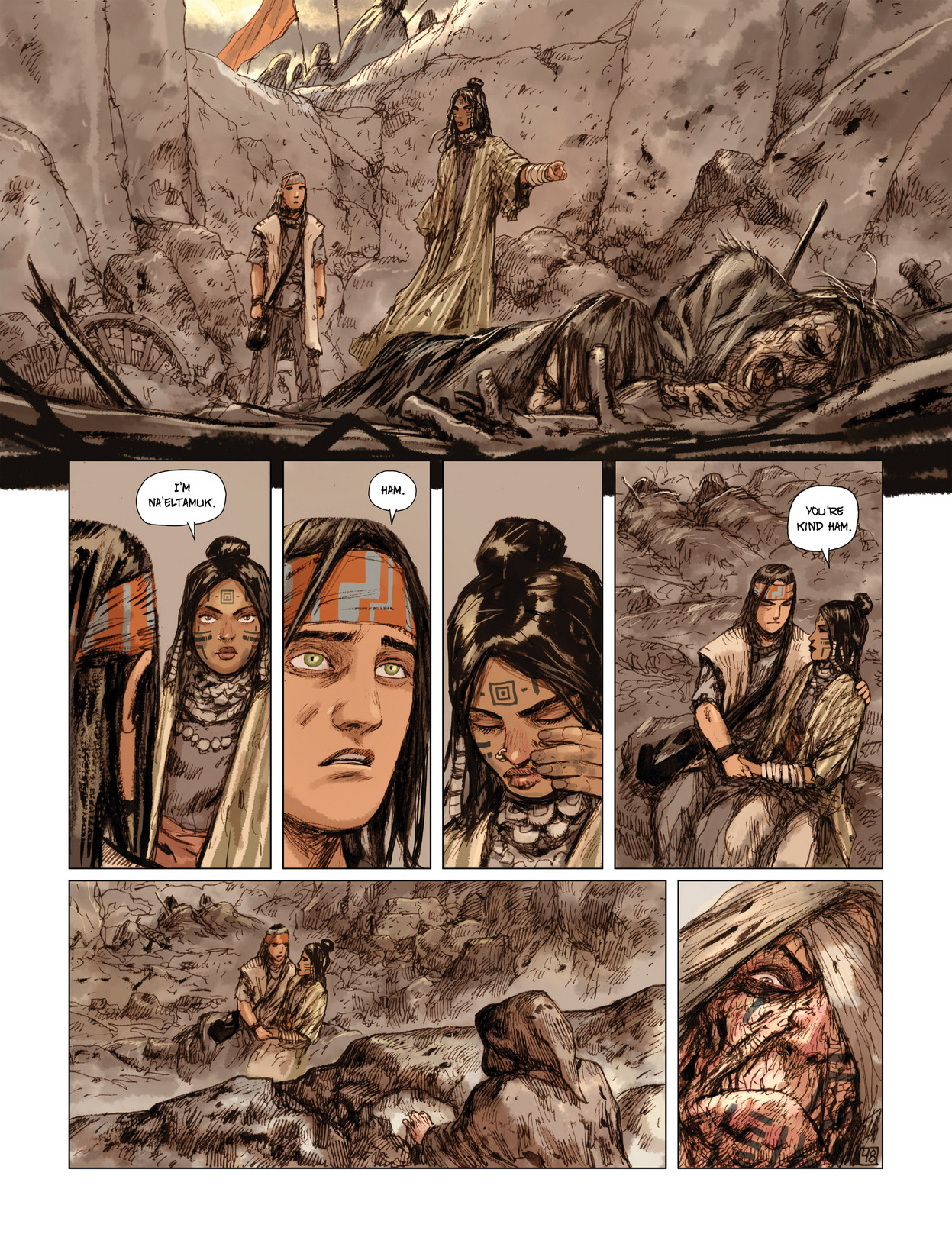
I wonder whether the body of Na'eltamuk's mother is missing from the movie because of the certificate. It may even have been a cut made before submission to the MPAA to ensure the lower age rating. But it is a moment that pulls on the heart strings in the graphic novel and its absence in the movie once more limits the sense of urgency and emotional tension in the way it is adapted for the screen.
The elements in the third act of the movie would have seemed to come properly out of nowhere if Noah hadn't been let off the hook regarding Na'eltamuk's death. In the movie she steps in an animal trap when she and Ham are running to the ark. Noah seems pragmatic there to insist that she be left behind, but in the graphic novel he actively kicks her out of the ark and has the watchers help him to do so. This is a shocking moment, but an important moment. Sure, it establishes earlier in the movie that Noah is willing to go to extremes to fulfil his duty. Even extremes which are too far for the audience. However, it also makes clear that Noah is responsible for deaths of humanity around him. Who knows how many people he could allow on the ark and who might even seem deserving. If we can hold back from feeling absolutely horrified with Noah for condemning Na'eltamuk to death like this (and I think few really can) it perhaps makes sense that Noah has decided that nobody really deserves to survive including himself. Noah and his family have a duty to save the animals and ensure their continuation, but Noah has decided that humanity must end for good and this horrifying act marks his commitment to that principle:
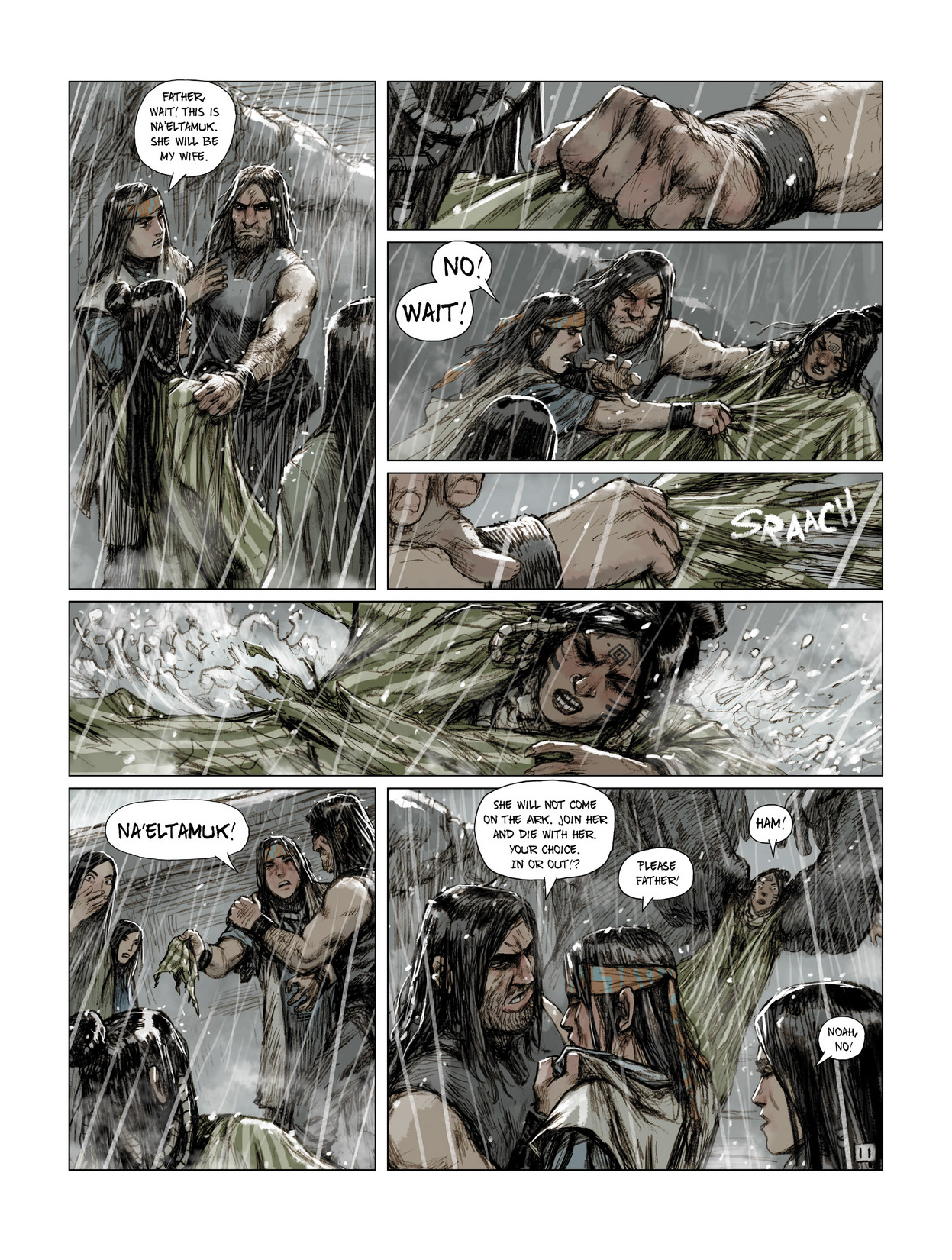
I think the graphic novel shows that there was potential for some rather more exciting fight choreography. Noah still gets to be quite a brutal badass protecting the ark from anyone trying to get on board in the movie too. But things get a little bit more bloody in the graphic novel.


But as we can see above, even at this stage Noah feels a sense of compassion and regret for what he must do. Once again, the balance between these two elements is something I felt the movie was missing. And in that one frame above we can see that this is still being centred around the relationship between Noah and Ham; a relationship which felt much less developed in the movie.
One element that was handled very well in the movie is the section below where the family is forced to ignore potential human survivors of the flood. There's an amazing shot of a rock sticking up from the flooded area where every inch of the area has people clinging desperately to it. It's quite a horrifying scene and it's interesting to see a shot in the movie which actually feels more shocking than what is shown in the graphic novel.
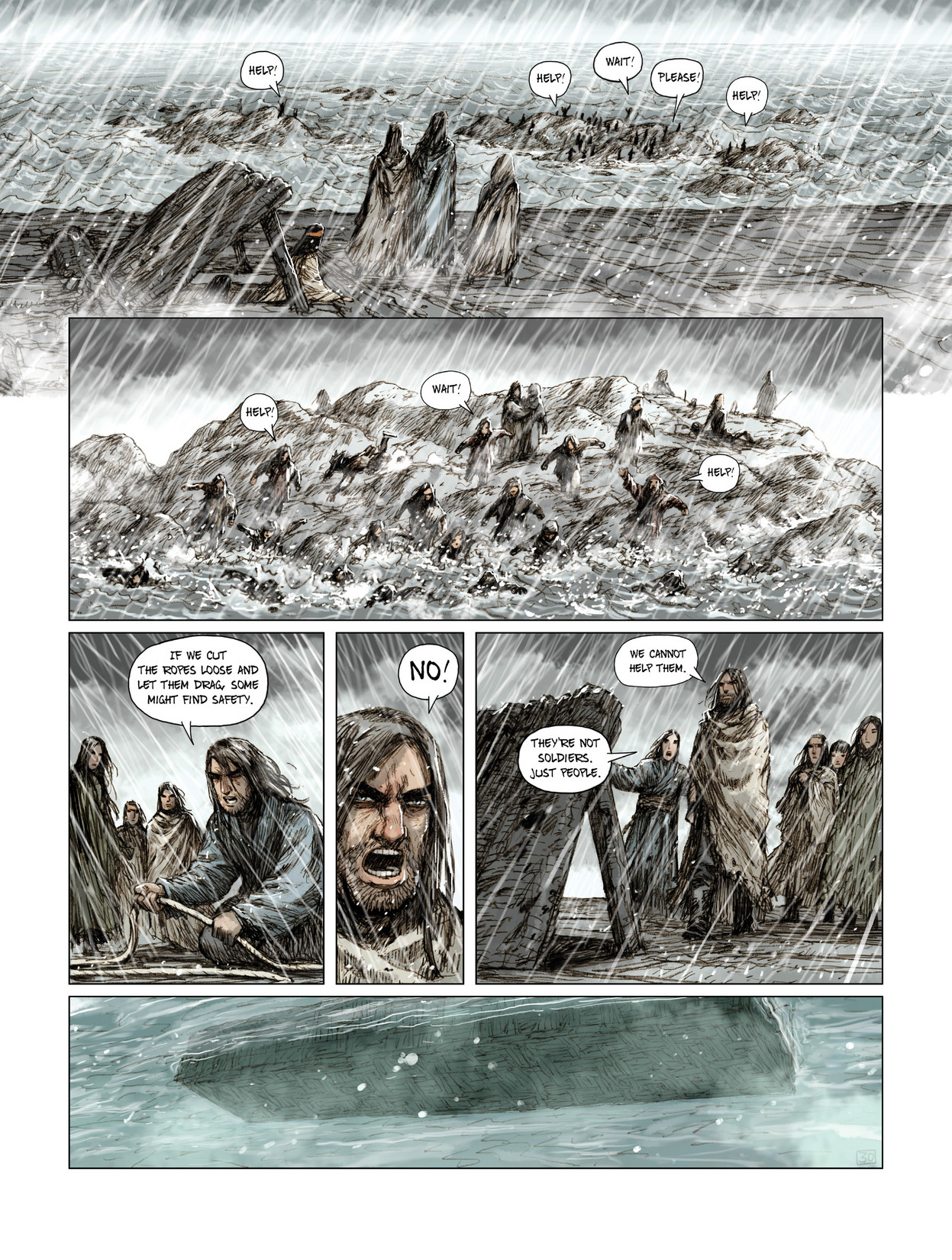
The role of Japeth
Noah's youngest son Japeth has some very important moments which they strangely decided not to include in the final film. When Tubal-Cain gets on board the ark, initially Ham sees him and his unwilling to let him die, but Japeth is the second person to discover Tubal-Cain and it is at that point that Ham is forced to question his priorities.

Japeth also acts as the explanation for why the dove is the one to find land. In the movie we see the raven fail, but we do not see the dove sent out instead. We only see the dove return. But Japeth actually gets to be pretty astute here, when he reasons that the dove might be more likely to persevere when all hope seems lost, while the raven was smart enough to recognise the poor odds of success. (This clearly tying to Noah's situation whereby he stubbornly acts out of faith when all reason seems to be against him.)

You'll notice that Ila says "my dove". This is callback to an earlier scene, also left out of the movie where she fixes a dove's wing, enabling it to join its partner on the ark. The dove is pretty major iconography for the Noah story and I was surprised that the sub-plot tying the dove more closely to the human protagonists was missed out.

The dove doesn't actually succeed on its first try, but Japeth is told to give it another chance and to wait on the rooftop for its return. However, at this stage all hope seems lost. Japeth is being sent up there so he does not see what happens to Noah's grandchildren who, if they turn out to be girls, Noah has sworn to murder - so convinced is he that humanity is not meant to live on. Though you'll notice that he shows more remorse here in the graphic novel. Maybe Russell Crowe just doesn't do remorse?

Why haven't Ila and Shem left the ark in their own raft? In the movie Noah destroys the Ark with fire (remarkably easily in fact), but in the graphic novel it seems like fate is preventing them from escaping, as though it were the will of God that they not be split up.
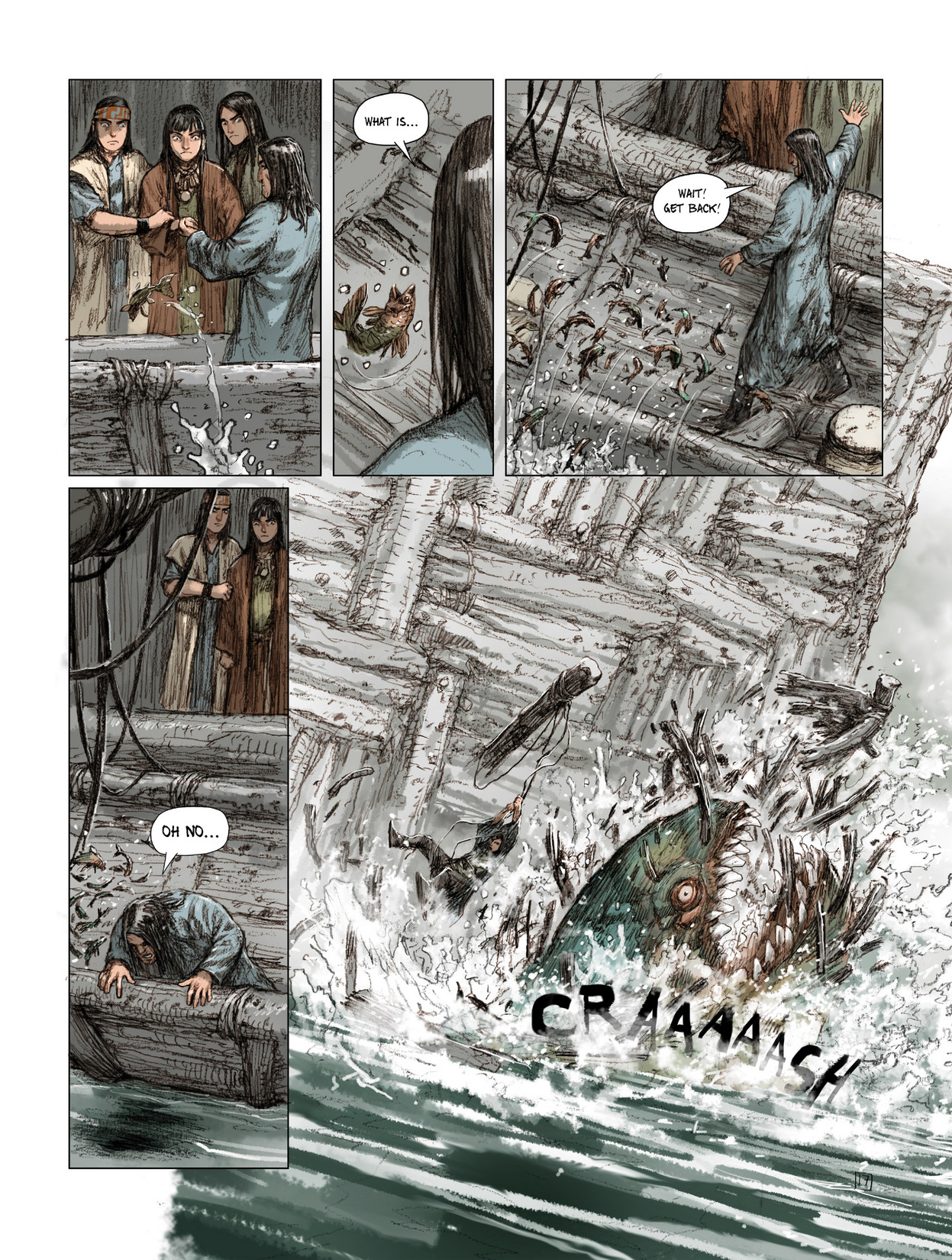
I think perhaps the movie wanted a more stark difference between the state of mind Noah is led to on the ark and his motivations when he is building the ark, but in the graphic novel I think it is much more sensible to show a more gradual shift from one to the other.
If he is set on destroying humanity, why should his family be spared? It is Tubal-Cain's arrogance which tells him that mankind is special and deserves to carry on in the face of the disaster, but Noah has no such arrogance. He does not consider himself special.
And that leads to him refusing to allow a girl to be brought into the world who might carry on the human race. And we have a scene in the graphic novel where Noah brings out a selection of animals to fight for this cause; turning into a clear conflict between the right of humanity to exist and the rights of the animals to continue without human interference. And the futures of certain species are ended in this struggle. (I thought the inclusion of a sabre-tooth tiger was a nice touch.)

At this stage Noah is still very much the prophet figure. Perhaps this scene was left out because it seems to show Noah as being provided with supernatural support (so that'd be from God, right?) even when he is at his least morally justified. But I think this is a scene which makes clear the "humanity or us" perspective of the animals which Noah is championing.
When the second of the twins is born, the family are overrun by animals and Noah has the upper hand and even here we see Noah reluctant to carry out what he has sworn to do. In the graphic novel Noah practically has tears in his eyes. Perhaps Russell Crowe doesn't do crying? (Actually it's notable that only Jennifer Connelly ever seems to do genuine tears in the movie. We keep getting what the 'The Guy With Glasses' vodcaster refers to as 'the sexy cry' where crying involves one small single tear rolling down their cheek.)

Later when Ila pleads only to be allowed to comfort her twins and lessen the horror of their final moments, it's an interesting change that in the original graphic novel Noah already has the babies. He doesn't have to demand them. It's an act of compassion that he hands them back knowing he has the upper hand.

I actually quite like how this element of the film has echoes of the story of "The Binding of Isaac". Noah truly believes that the child must die and at the last minute comes to realise that it is not God's will that this should happen after all. The decision to combine the themes of these two stories actually seems rather smart. It is vital that the audience recognise the full horror involved in the flood and do not cheer it on as if it were the simple triumph of good over evil. Noah isn't a pro-life story. It questions whether mankind deserves their place in the world. It features the mass slaughter of human beings on Earth, even if the story traditionally hasn't shown Noah with quite so much literal blood on his hands.
The ending of the story. How important is Biblical accuracy?
The graphic novel makes a nod to the final part of the Noah story in the Bible with this scene where Noah is lying drunk and naked on the land they have discovered. However, carrying on with the theme from before, Ham looks set to kill Noah. And why wouldn't he? Why would any of us have forgiven Noah for what he did to Na'eltamuk? (Never mind his murderous designs on his grandchildren on the ark?)
However, it's a sign of hope that Ham seems to somewhat forgive Noah, leaving him with the piece of cloth that remained of Na'eltamuk's clothing when she was pulled away from Ham and sent to her doom .

So why is Noah lying naked and drunk? Well the section of the Bible in question is as follows:
Noah, a man of the soil, proceeded to plant a vineyard. When he drank some of its wine, he became drunk and lay uncovered inside his tent. Ham, the father of Canaan, saw his father naked and told his two brothers outside.
But Shem and Japheth took a garment and laid it across their shoulders; then they walked in backward and covered their father’s naked body. Their faces were turned the other way so that they would not see their father naked.
When Noah awoke from his wine and found out what his youngest son had done to him, he said,
“Cursed be Canaan!
The lowest of slaves
will he be to his brothers.”
He also said,
“Praise be to the Lord, the God of Shem!
May Canaan be the slave of Shem.
May God extend Japheth’s territory;
may Japheth live in the tents of Shem,
and may Canaan be the slave of Japheth.
”Genesis 9: 20-27
Canaan is actually Ham's son. It is quite odd how Ham is cursed by Noah simply for seeing his father naked. In the movie they have decided to include the whole bit with Shem and Japeth walking backwards with a sheet and it really doesn't work terribly well.
We then have a conversation between Noah and Ila, but in the original graphic novel he seems a great deal more apologetic.
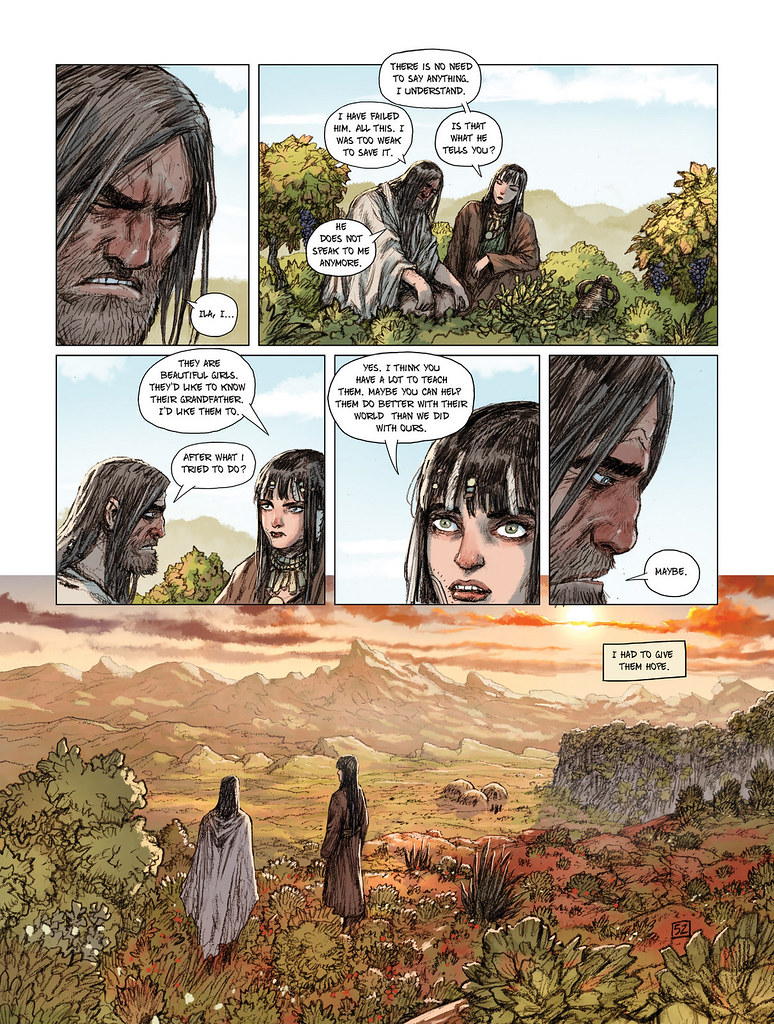
The final scene in the graphic novel is Noah making peace with his wife. There is no dialogue involved. There's certainly no sign of the self-congratulatory upbeat ending of the movie. And I think the attempt to shoehorn a happy ending into this dark tale makes me all the more resentful of it. This isn't a happy story and it shouldn't be a happy story. But what I liked about the graphic novel is that it makes the story about human shame and not about one family's self-righteousness.